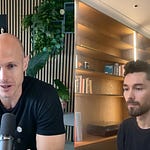In today’s episode of the EUVC podcast, Andreas talks with Ingrid Bonde Åkerlind, a seasoned investor at Oxx, a venture capital firm focusing on B2B SaaS companies that operate from London and Stockholm. Backed by a $190 million second fund and a boutique, high-conviction approach, Oxx targets late Series A and Series B companies that have not only passed the product-market fit gauntlet but are now ready to scale. Ingrid’s unique blend of hands-on operational experience and investment insight helps her spot startups that truly understand their market dynamics.
Drawing on her journey from building growth teams to steering venture investments, Ingrid explores the power of a well-defined Ideal Customer Profile (ICP). She explains how transitioning from an experimental phase to a focused customer strategy can align sales, marketing, and product teams for sustained success. In this conversation, she shares practical insights on refining go-to-market strategies and leveraging data-driven customer segmentation to drive operational efficiency and venture-scale returns.
Watch it here or add it to your episodes on Apple or Spotify 🎧 chapters for easy navigation available on the Spotify/Apple episode.
How Top VCs Identify Emerging Sectors First
AlphaSense gives VCs a competitive edge—surfacing hidden market shifts, emerging sectors, and expert insights before anyone else. Supercharge due diligence, refine deal flow, and outmaneuver competitors effortlessly.
✍️ Show notes
Why is ICP dear to my heart?
So today’s topic is really basic in many ways but it’s one that I care quite a lot about. Knowing who your ideal target customer, or your ideal customer profile - ICP is. I’m not the first person to speak about this, nor the last.
But there’s probably two core reasons I really care about this.
First, personal experience as an operator. When I arrived at Volumental - my previous employer - as their first marketing hire in 2018, I asked “ok, so what’s our target customer segment” and the answer I got was “huh?”
This company was full of brilliant computer vision scientists and PhDs. People were smart. Like super smart. But the company had grown via founder sales and all the intuitive knowledge was locked up in their brains. That breaks down post-PMF when your goal is to scale the GTM team.
So getting the company’s ICP down on paper became my responsibility. And that helped us onboard new GTM hires more efficiently and ultimately - although it was difficult to prove quantitatively - shorten sales cycles.
Second, if I put on the investor lens, it’s so disappointing when I’m talking to a really interesting potential investment opportunity - great metrics, growing well - but they cannot describe their ICP well.
I don’t care because I’m ticking a box - are they focused? No? Straight pass… but because it’s what we need to build conviction that the company understands how to efficiently transform a multi-million dollar investment into growth.
Two companies approaching Series A: the one that understands why it’s growing well and who exactly are its best-fit customers is much likelier to continue on the same trajectory and weather the bumps that invariably arise on the scaling path.
And honestly, most companies you invest in continually work on positioning. Their target customers change over time. That’s completely normal. But knowing who they are at any given point in time? Very important.
What’s the problem with the current advice?
Typical advice is a bit too simplistic. It’s “find a focus” “find a focus” - which doesn’t take in to account that companies at different stages should think about this very differently, and I’m happy to come on to that.
And second, what makes a good ICP is sometimes misunderstood. It’s often relayed in pretty firmographic ways when that’s not necessarily what matters.
The ICP bowtie
So the way I like to think about it that a company’s ICP journey follows a bowtie shape.
So first, imagine a bowtie. Can you picture it in front of you?
So imagine now that the horizontal axis is your company getting more and more mature and growing larger and larger. The left side of the bowtie is your company in a pre-product market fit state.. The middle is when you’re just at the PMF stage. And the right side is when you’ve passed through the PMF gauntlet and you’re now approaching GTMF.
Still have that visualization in your head?
Ok, so now let’s imagine customers inside the bowtie. In an ideal world, this is how I’d visualize your ICP journey
In the pre-PMF phase - that’s the LEFT side of the bowtie - you’re experimenting. You have a great product and you’re figuring out who needs it the most. You’re talking to tons of different customers. You’re acquiring customers in lots of different segments. None of the customers here are the same! There isn’t focus! And that’s totally ok!
As you pass through that PMF phase - that’s the center of the bowtie - you need to flip this around. You need to say no. You need to go after a single, strong ICP with a scaleable GTM motion. You’ve figured out who needs your product the most, now you need to double down and go after these, and only these customers. So all the new customers should start looking the exact same.
It’s first in that post-PMF phase that you slowly, slowly earn the right to take on a new type of customer at scale. Because of course, to build a giant giant company you will have more than one type of customer. But the key is to resist the urge and temptation to do that until you have the internal resources and capabilities to truly serve your multiple types of customers well.
So that’s theory. What does reality look like?
Well, there’s companies without a focus. I think that’s quite rare actually.
What’s more common is companies that have grown well, and continued to scale, but define their ICP after-the-fact. We sell to this financial services and healthcare and manufacturing” ” or “we sell to both SMB and MM and enterprise clients within this industry” - there’s a lack of prioritization of which segment has the best potential.
But honestly, there’s a lot of companies who do take this seriously, and approach product-market fit, and then still end up defining ICP in a very “firmographic” sense, e.g. “We sell to CFOs at companies in professional services in DACH and France with $50 to $500m in revenue”
What does a good one look like?
Let’s grade my own work… one of the reasons I really cared about this is because the impact I felt working on this at my previous employer Volumental had on the company
So let’s grade my own work…
Volumental’s product was a 3D foot scanner - maybe 1 square meter large - that is placed in to physical stores. Customers could step on to a foot plate, scan their feet, and then browse through a personalized ranking of the shoes in that store’s inventory that would best fit their feet on a connected iPad.
Ok, so when I arrived there were clearly strong intuitions: best-fit customers cared about “fit” and hence there were a lot of athletic customers in the customer base. What we needed to do was pressure test this hypothesis. Building from that intutition, we were able to arrive at a much more specific ICP definition.
Furthermore, once we had nailed this down, it actually did help us also analytically think through which segments might be the best “next” ones - where did everything except for just one thing work? From a sub-segment perspective, that was kids shoes.
So if you were to generalize?
The main point here is that this is about a lot more than just industry or employee size ranges. Of course industry, buyer persona, geography and revenue range still matter and they’re still at the core of a most ICPs.
Yet, the far more insightful areas come from beyond this.
Tech stack is relatively common - is your solution replacing existing solutions, or is it better suited for a certain tech stack due to integrations? Or in industries where they’re moving from best-of-breed to all-in-one, how does that impact it?
Who owns the problem matters a lot. Some areas might be owned by finance in one company, operations in another, data in a third - understanding the structure of the org chart matters
Culture - is you best customerROI-driven? Make innovative bets? Are they more digitally savvy or less digitally savvy than others in their industry?
And what about the product they provide the market? Is it complex or simple?
What does the team you’re selling in to look like? Is it centralized, decentralized? Full of specialists or generalists?
This is often the most important ones, because this is what creates the similarity in pain point and urgency which is what you’re actually after.
I’ll stress that again. What you’re really trying to do in mapping your ICP is not coming up with just a list of criteria, but you’re defining what characteristics of an organization make it have better or worse PMF. What characteristics increase the size and urgency of the problem which makes them want to buy your solution.
What goes wrong if you don’t do this?
You probably don’t notice anything at first. You grow quickly, you raise more money, you expand the team. But misalignment starts setting in.
Until a certain point, misalignment is often caught, but it’s painful and stressful to reprioritize. The life of a startup means that every team member needs to be able to react quickly to change, but reduce the self-imposed errors. Fewer last-minute reprioritizations and less wasted effort.
Second, companies that serve multiple target segments risk spreading themselves too thin. You see this when the product roadmap is pulled in to multiple directions because different segments have subtly different needs. But you can also see it in sales & marketing - product marketing and sales enablement are much more challenging if they cover multiple target segments or have such a broad target segement that they struggle to be specific.
Hah, and then there is the classic marketing and sales misalignment. I don’t think I even need to explain this one?
So what happens? Sales and marketing efficiency goes down, burn goes up, and your investors might start losing faith and a company with great product and product-market fit doesn’t reach its true commercial potential.
Let me challenge you, what about a PLG company?
It’s a really fair point. You’re basically allowing anybody to sign up to start using your product, so how can you control and focus your customer base?
Two things
First, is the website messaging and popsitioning opinionated?
Second, as the company builds out a sales team to upsell customers, is there a clear understanding of who they should upsell to? Who are the most likely customers who will grow?
Theory is good, but how do you put this into practice?
I think there’s four basic types of data you can look at to identify your best-fit ICP. What you first want to do is assemble a pretty big list of all the possible indicators you might think of - geography, size, team qualities, company qualities, tech stacks, etc. And then you’re looking at each on what’s a better or worse fit.
First, your customer MRR data. You want to look at your cohorted data on gross and net retention, per segment. And split this in to segments. You likely already have your customer base tagged by company size and geography - so compare these metrics across those. You can then tag your customers base according to some of the other criteria in your hypothesised ICP and see whether it indeed leads to higher retention or upsell. Higher retention or upsell typically means you customers see more value in your product and are a better ICP fit.
Second, your sales CRM data. What’s tricky here is that you may not always have historical leads tagged with these criteria and you can’t figure it out. If so, it’s time to start getting the sales team to tag this information on incoming deals. Is this annoying? Yes. Is this incredibly useful? Yes. Is it forever - no, you’ll likely figure out what’s worth storing and not.
After c. one sales cycle, you should be able to look back and see where sales cycles or conversion rates are better. Or whether willingness-to-pay and ACV is higher. This is a decent proxy for better CAC and therefore, better unit economics.
Product data is another great source of information, especially for high-usage products. You can start tracking key product actions per account. You can group accounts by criteria and track the average trendlines over time. This helps you identify whether your hypothesized criteria are indeed predictive of accounts that take actions in the product that reflect them receiving more value from the product.
Finally, market data matters! Task one team with the outside-in analysis - how many target accounts are there in a given area? Are there certain subsegments that are more or less competitive?
Who is responsible for this internally?
The CEO. Hah, that’s always that easy answer right? Over time, product marketing is typically responsible for coordinating the work, but this is an area that needs complete buy-in.
A nice definition on a slide is good, but what would you use this for?
So per team, that cascades in to more operational goals
Marketing can better tailor digital spend to this specific persona, focus spend - and also confidently pay a little more for certain leads knowing that they have a higher chance of converting and become good customers
Sales can build lead lists for SDRs
Sales can also better triage incoming deals and filter more confidently, sooner
The product team can prioritize the product roadmap better
And the customer success team has a more powerful tool at hand to prioritize accounts
How can you tell if a company is really using this, and it’s not just words?
As an investor, it’s hard to tell. But I think the key tell during a fundraising process is if each of the functional leaders you speak with - be it sales, marketing, or product - paint a picture of the same perfect customer when you speak to them. They might not use the exact same words, but they’re clearly in sync.
Some things are made for platforms - music, cabs & pizzas. But fund solutions aren’t one of them. Their individual client focus and regulation-first approach is your guarantee for flexible solutions accommodative to a broad range of deal and client specifics. The kicker? Prices that match any of the shelf-products in the market.
🤗 Join the EUVC Community
Looking for niche, high-quality experiences that prioritize depth over breadth? Consider joining our community focused on delivering content tailored to the experienced VC. Here’s what you can look forward to as a member:
Exclusive Access & Discounts: Priority access to masterclasses with leading GPs & LPs, available on a first-come, first-served basis.
On-Demand Content: A platform with sessions you can access anytime, anywhere complete with presentations, templates and other resources.
Interactive AMAs: Engage directly with top GPs and LPs in exclusive small group sessions — entirely free for community members.
✍🏻 EUVC Masterclass | Marketing Foundations for Fund Managers
Join us for an engaging workshop tailored for fund managers looking to institutionalise their marketing approach and craft a category-defining investment brand.
This masterclass is designed to go beyond traditional marketing advice on tactics to help you create lasting brand equity, ensuring your fund stands out in a competitive landscape.
This session will provide actionable insights into fund positioning, LP communications, and crafting compelling narratives - all while maximising time for Q&A to address your specific challenges.
⏰ March 13 | 💻 Online |
💬 Community event | LP AMA with Ertan Can
Join us for an exclusive AMA session with Ertan Can, Founder & Managing Partner at Multiple Capital.
Ertan Can is the Founder & Managing Partner of Multiple Capital, Europe’s first tech-focused fund of micro funds. With over 20 years of experience in asset management, VC, and fund of funds investing, he has backed 31+ early-stage VC funds and built a portfolio of 500+ companies. His mission is to democratize access to early-stage tech funds across Europe and the US.
This AMA is part of our ongoing series of small-group sessions designed to foster deep, meaningful discussions within the VC community. Participation is free for members of our community, but spots are limited. Reserve your spot now to ensure you don’t miss this opportunity.
⏰ March 13 | 💻 Online | THIS EVENT IS FOR EUVC COMMUNITY MEMBERS ONLY.
✍🏻 EUVC Masterclass | Marketing Foundations for Fund Managers
Join us for an engaging workshop tailored for fund managers looking to institutionalise their marketing approach and craft a category-defining investment brand.
This masterclass is designed to go beyond traditional marketing advice on tactics to help you create lasting brand equity, ensuring your fund stands out in a competitive landscape.
This session will provide actionable insights into fund positioning, LP communications, and crafting compelling narratives - all while maximising time for Q&A to address your specific challenges.
⏰ March 13 | 💻 Online |
✍🏻 EUVC Masterclass | Setting up and Structuring a VC Fund
Emerging fund managers face countless challenges when setting up and structuring their first VC fund. The process is complex, daunting, and full of pitfalls, from navigating legal frameworks to engaging with the right service providers, the foundations you lay now will shape your growth trajectory.
That’s why we’re planning an exclusive 3-hour masterclass designed to equip emerging managers with the insights, strategies, and tools needed to tackle these challenges head-on.
⏰ Jun. 02 | 🇩🇪 Berlin | This masterclass is a side-event taking place during SuperVenture & SuperReturn.
🗓️ The VC Conferences You Can’t Miss
There are some events that just have to be on the calendar. Here’s our list, hit us up if you’re going, we’d love to meet!
0100 Europe 2025 | 📆 02 - 04 April 2025 | 🇳🇱 Amsterdam, The Netherlands
0100 Emerging Europe 2025 | 📆 14-16 May 2025 | 🇭🇺 Budapest, Hungary
GITEX Europe 2025 | 📆 23 - 25 May 2025 | 🇩🇪 Berlin, Germany














